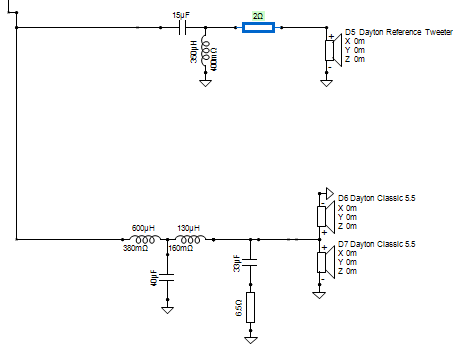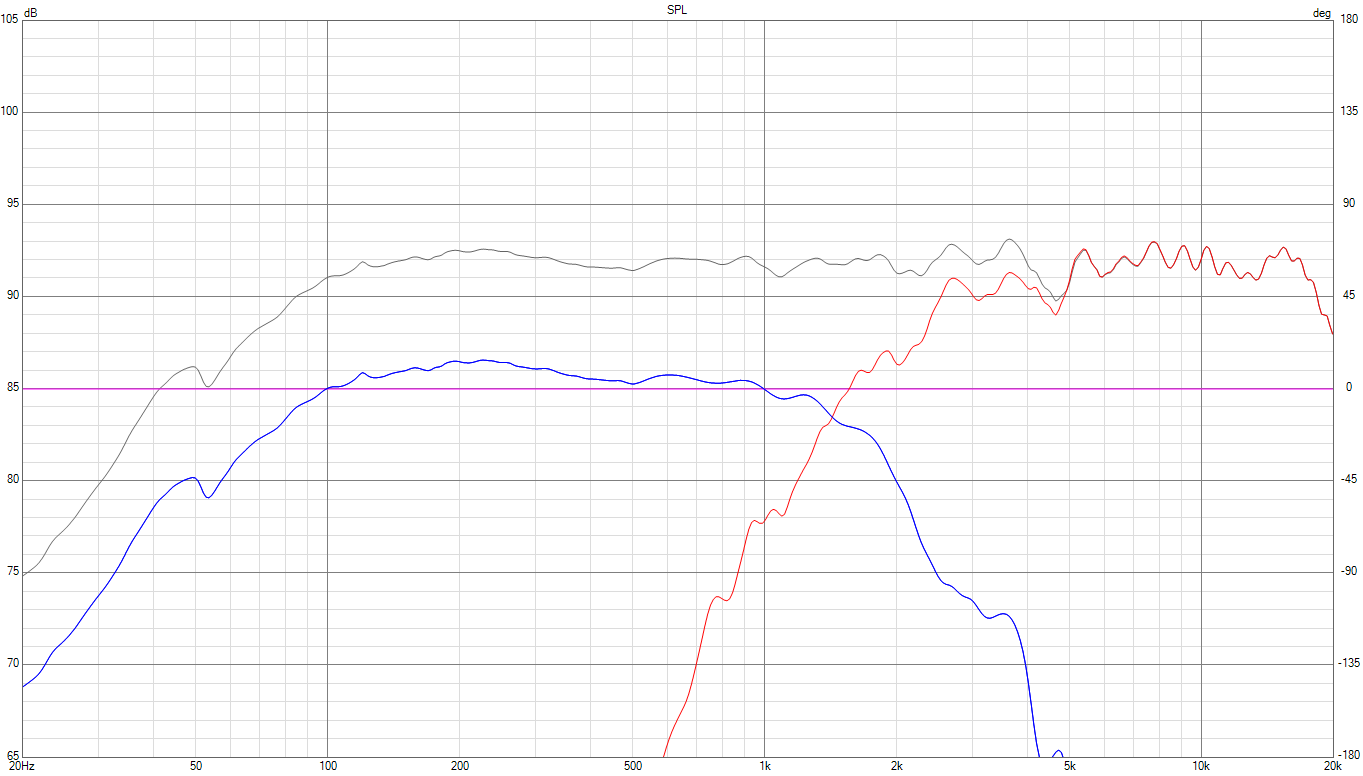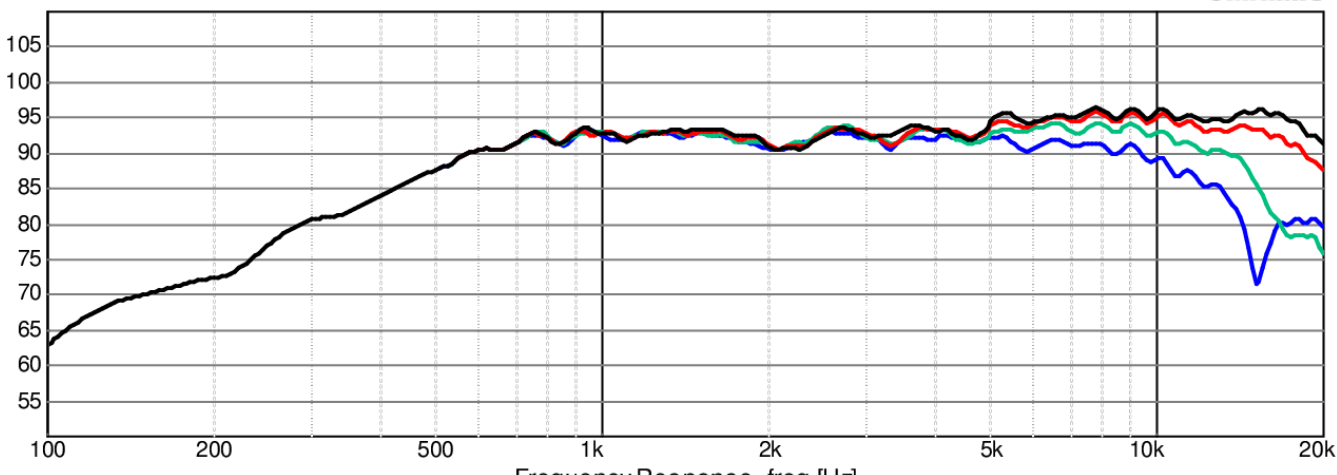Hello, over the past couple of days, I have been looking to design and build a speaker. The drivers I am using in my design are the following:
1x Dayton RST28F-4 Tweeter Dayton Audio - RST28F-4 1-1/8" Reference Series Fabric Dome Tweeter 4 Ohm
2x Dayton DC130A-8 Woofers Dayton Audio - DC130A-8 5-1/4" Classic Woofer Speaker 8 Ohm
The cabinet would be ~.92 cubic feet tuned to 60 hz.
The following pictures are the crossover design, SPL graph, and all graphs listed in VirtuixCAD.
I am wondering if you have any thoughts about the crossover design. Here are a couple of questions I have.
Should the 3db dip around 4600hz be any cause for concern?
I've read about baffle step / diffraction, do you think this would cause issues?
When building a crossover, does the type of capacitor matter (poly vs NPE)?
Calculating the total cost to build this speaker and cabinet came out to ~$350. Would this speaker be worth the money compared to retail speakers assuming the finish was equally as good?(I enjoy building so that part wouldn't be considered a chore, also I know there are a lot of factors affecting this but more of a general question if the speaker came out close to the simulation)



1x Dayton RST28F-4 Tweeter Dayton Audio - RST28F-4 1-1/8" Reference Series Fabric Dome Tweeter 4 Ohm
2x Dayton DC130A-8 Woofers Dayton Audio - DC130A-8 5-1/4" Classic Woofer Speaker 8 Ohm
The cabinet would be ~.92 cubic feet tuned to 60 hz.
The following pictures are the crossover design, SPL graph, and all graphs listed in VirtuixCAD.
I am wondering if you have any thoughts about the crossover design. Here are a couple of questions I have.
Should the 3db dip around 4600hz be any cause for concern?
I've read about baffle step / diffraction, do you think this would cause issues?
When building a crossover, does the type of capacitor matter (poly vs NPE)?
Calculating the total cost to build this speaker and cabinet came out to ~$350. Would this speaker be worth the money compared to retail speakers assuming the finish was equally as good?(I enjoy building so that part wouldn't be considered a chore, also I know there are a lot of factors affecting this but more of a general question if the speaker came out close to the simulation)



It looks as though you have measured something secondary there, is that the reason for the dips?Should the 3db dip around 4600hz be any cause for concern?
Measuring properly should get you to a reasonable solution, have you measured according to VC recommendations?I've read about baffle step / diffraction, do you think this would cause issues?
Much more. However maybe not the first time you listen to it. It can take time.Calculating the total cost to build this speaker and cabinet came out to ~$350. Would this speaker be worth the money compared to retail speakers
Well, I took these .frd graphs directly from the manufacturer's website to design my crossover. The tweeter's response has a dip in it which as far as I know cannot be removed through crossover design. Here is a photo of the tweeter's curve.It looks as though you have measured something secondary there, is that the reason for the dips?

Well, as mentioned answering your first question, I have not actually measured these speakers in person. I do plan on buying a condenser mic such as a behringer ECM8000 and measuring them in person using REW.Measuring properly should get you to a reasonable solution, have you measured according to VC recommendations?
I haven't really listened to any high-quality speakers before. I had a pair of B652-Air speakers, and I believe those were the best sounding speakers I have heard. I could definitely tell a drastic difference in clarity compared to a cheap soundbar I use.Much more. However maybe not the first time you listen to it. It can take time.
Regarding these three points again, firstly I'm not certain whether this is a resonance, I'd consider treating it like one and using the crossover to fix it. Some wouldn't try.
Second yes, the baffle is a compromise worth compensating.
Third, a good speaker sounds like the real thing, and you shouldn't have to try in convincing yourself of that.
Second yes, the baffle is a compromise worth compensating.
Third, a good speaker sounds like the real thing, and you shouldn't have to try in convincing yourself of that.
" tuned to 60 hz" - why so high?
My instinct would be to reverse the orders of the crossover i.e. 2nd order on the woofer, 3rd on the tweeter
'baffle step / diffraction' - phrasing it like that implies you think they're the same thing; they're not. Diffraction is dealt with by the design of your box (rounding of corners etc); baffle step depends on the placement in the room of the box & is dealt with in the crossover. Liking a solid bottom end (!) I try to ensure I've got 3 or 4 dB extra below the Baffle step frequency no matter what...
My instinct would be to reverse the orders of the crossover i.e. 2nd order on the woofer, 3rd on the tweeter
'baffle step / diffraction' - phrasing it like that implies you think they're the same thing; they're not. Diffraction is dealt with by the design of your box (rounding of corners etc); baffle step depends on the placement in the room of the box & is dealt with in the crossover. Liking a solid bottom end (!) I try to ensure I've got 3 or 4 dB extra below the Baffle step frequency no matter what...
I've found it's pretty hard to find information on the more complex aspects of designing a crossover. This is the first one I've designed, and I feel like it's pretty decent. Hoping someone who has more crossover designing knowledge can tell me if I'm overlooking anything really. I'll probably play around with this a little more and see if I can put together something better.
I can tell you I can't design a good crossover as quickly as you. 😉
What would you call better, when you say 'something better'?
What would you call better, when you say 'something better'?
Well I have it tuned this way with a .92 cubic foot box. It's a littler higher but gives me +1-2 db from 80-100 hz. I have a subwoofer so I figure I might be using an 80hz crossover on my receiver which would even out the low end curve." tuned to 60 hz" - why so high?
I chose a 3 way for the woofers because on their frequency graph they have some pretty high breakup frequencies around 2-3khz. The tweeter has a more flat response on the lower frequencies.
I do realize the step / diffraction are completely different. I could easily add some db to the low end below the baffle step frequency. How much would this matter if the speakers were placed closely to a wall though.
What would you call better, when you say 'something better'?
Well after all this is just a simulation. As PeteMcK says, the baffle step could be lowering the spl of my low end by 4db, I've heard some people say 6db. If this was the case, my simulation would not match my real world test. The speaker would end up lacking in the low end.
"1-2 db from 80-100 hz. I have a subwoofer " - good move
'pretty high breakup " - don't look that bad to me....
' How much would this matter' - comes down to personal preference, if you're using a sub with variable xover frequency, probably not at all
'pretty high breakup " - don't look that bad to me....
' How much would this matter' - comes down to personal preference, if you're using a sub with variable xover frequency, probably not at all
- Home
- Loudspeakers
- Multi-Way
- DIY 2 Way Speaker Design Thoughts